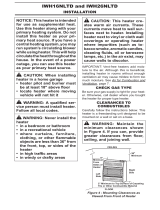
www.desatech.com
111515-01J4
1. This appliance is only for use with the type
of gas indicated on the rating plate. This
appliance is not convertible for use with
other gases.
2.
Do not place propane/LP supply tank(s) in-
side any structure. Locate propane/LP supply
tank(s) outdoors (propane/LP units only).
3. If you smell gas
• shut off gas supply
• do not try to light any appliance
• do not touch any electrical switch; do not
use any phone in your building
• immediately call your gas supplier from
a neighbor’s phone. Follow the gas
supplier’s instructions
• if you cannot reach your gas supplier,
call the re department
4.
This heater shall not be installed in a bedroom
or bathroom, unless installed as a vented
appliance. See Installing Damper Clamp
Accessory for Vented Operation, page 11.
5. Before installing in a solid fuel burning re-
place, the chimney ue and rebox must
be cleaned of soot, creosote, ashes and
loose paint by a qualied chimney cleaner.
Creosote will ignite if highly heated. A dirty
chimney ue may create and distribute
soot within the house. Inspect chimney
ue for damage. If damaged, repair ue
and rebox before operating heater.
6. Do not burn solid-fuel in a masonry or
UL127 factory-built replace in which a
vent-free room heater is installed.
7. If replace has glass doors, never operate
this heater with glass doors closed. If you
operate heater with doors closed, heat
buildup inside replace will cause glass to
burst. Make sure there are no obstructions
across opening of replace.
8. To prevent the creation of soot, follow the
instructions in Cleaning and Maintenance,
page 21.
9. Before using furniture polish, wax, carpet
cleaner, or similar products, turn heater off. If
heated, the vapors from these products may
create a white powder residue within burner
box or on adjacent walls and furniture.
10. This heater needs fresh, outside air ven-
tilation to run properly. This heater has an
Oxygen Depletion Sensing (ODS) safety
shutoff system. The ODS shuts down the
heater if enough fresh air is not available.
See Air for Combustion and Ventilation,
page 5. If heater keeps shutting off, see
Troubleshooting, page 23.
11. Do not run heater
• where ammable liquids or vapors are
used or stored
• under dusty conditions
12. Do not use this heater to cook food or burn
paper or other objects.
13. Do not use heater if any part has been ex-
posed to or under water. Immediately call
a qualied service technician to inspect
the room heater and to replace any part
of the control system and any gas control
which has been under water.
14. Do not operate heater if any log is broken.
Do not operate heater if a log is chipped
(dime-sized or larger).
15. Turn heater off and let cool before servic-
ing, installing, or repairing. Only a qualied
service person should install, service, or
repair heater.
16. Operating heater above elevations of
4,500 feet may cause pilot outage.
17. To prevent performance problems, do not
use propane/LP fuel tank of less than 100
lb. capacity (propane/LP units only).
18. Provide adequate clearances around air
openings.
LOCAL CODES
Install and use heater with care. Follow all
local codes. In the absence of local codes,
use the latest edition of The National Fuel
Gas Code ANSI Z223.1/NFPA 54*.
*Available from:
American National Standards Institute, Inc.
1430 Broadway
New York, NY 10018
National Fire Protection Association, Inc.
Batterymarch Park
Quincy, MA 02269
Note: Where listed vented decorative logs
are required, thermostat operation is not
permitted.
State of Massachusetts: The installa-
tion must be made by a licensed plumber
or gas fitter in the Commonwealth of
Massachusetts.
Sellers of unvented propane or natural
gas-red supplemental room heaters shall
provide to each purchaser a copy of 527
CMR 30 upon sale of the unit.
Vent-free gas products are prohibited for
bedroom and bathroom installation in the
Commonwealth of Massachusetts.
SAFETY
Continued
























